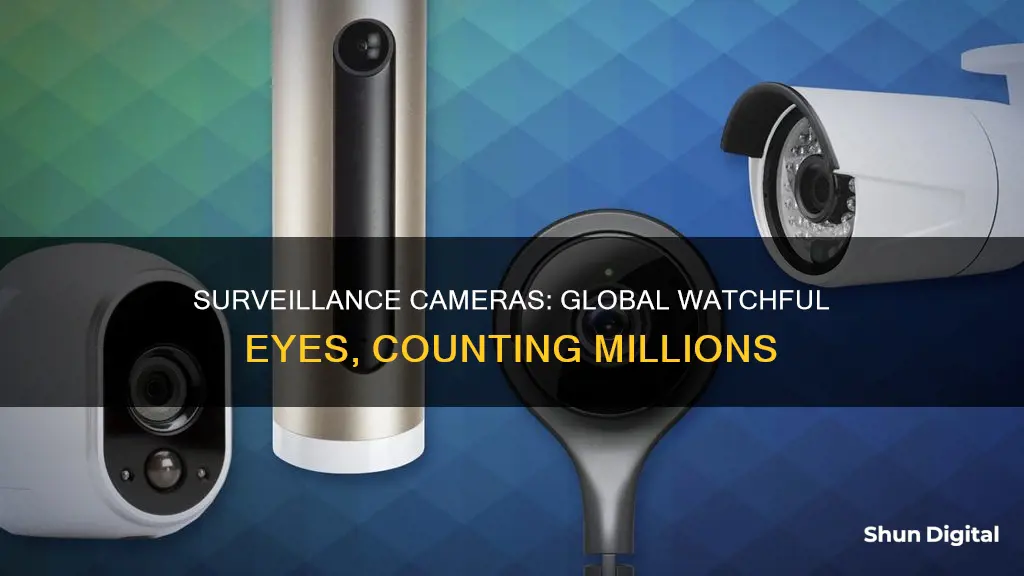
There are an estimated one billion surveillance cameras installed worldwide, with China accounting for over half of the global total. In 2018, China had one camera for every 4.1 people, while the US had one for every 4.6 people. The number of surveillance cameras worldwide is expected to continue to increase, with China's installed base predicted to rise to over 560 million cameras by 2021, and the US rising to around 85 million cameras.
| Characteristics | Values |
|---|---|
| Number of surveillance cameras in the world | 1 billion |
| Year when the one-billionth CCTV camera was predicted to be installed | 2021 |
| Number of surveillance cameras in China | 626 million |
| Number of surveillance cameras in the US | 85 million |
| Number of surveillance cameras in the UK | 70,882 |
| City with the highest density of CCTV cameras | Chennai, India |
| City with the most CCTV cameras in the US | New York |
| City with the most CCTV cameras in the world | Beijing, China |
What You'll Learn

China has the most surveillance cameras
China's heavy surveillance is not a new phenomenon. Mass surveillance in China emerged during the Maoist era after the establishment of the People's Republic of China in 1949. Mao invented this mechanism of control to strengthen his power in the newly founded government. In the early years, when technology was less developed in China, mass surveillance was achieved through word-of-mouth dissemination of information. Chinese citizens kept a watchful eye on one another and reported any inappropriate behaviors that infringed upon the dominant social ideals of the time.
In 2005, the Chinese government created a mass surveillance system called Skynet, which included over 20 million cameras by 2013. The system was used to monitor the general public, with cameras installed outside mosques in the Xinjiang region, temples in Tibet, and the homes of dissidents. Feminists and LGBT rights groups are also subject to increased scrutiny.
China has been a fervent adopter of facial recognition technology, which is often used to restrict individuals' freedom of movement, such as restricting access to public transportation. Additionally, the Chinese government has been strengthening its tight control over the internet and digital communication. There are more than 750 million internet users in China, and their online actions are strictly regulated. The Chinese government has also been working on a nationwide video surveillance network, aiming to ensure public security and be omnipresent, fully networked, working all the time, and fully controllable.
The heavy surveillance in China has sparked concerns about data privacy and security. While the government claims that the surveillance prevents crime, citizens worry that their data and privacy could be compromised. Additionally, critics argue that the smart city programs, which include the installation of public security cameras, are used as a form of social control to target dissidents and crack down on any potential unrest.
Despite the concerns, some Chinese citizens support the extensive surveillance measures, believing that it improves their safety. The surveillance cameras have been credited with reducing crime and helping recover lost items. However, critics argue that the trade-off between security and privacy may not be worth it, especially when considering the potential for misuse and abuse of the collected data.
A Year of Camera Tickets: How Many is Too Many?
You may want to see also

One billion cameras globally by 2021
In 2019, IHS Markit predicted that there would be one billion surveillance cameras worldwide by the end of 2021. This is a significant increase from the 770 million surveillance cameras that were estimated to be installed globally in 2019. According to the report, more than half of the cameras in 2021 would be in China, which is consistent with the distribution in 2019, where 54% of the cameras were located in China.
China's extensive network of surveillance cameras has raised concerns among experts about the potential risks of such technology, particularly regarding possible data access by the Chinese government. China's push to export surveillance camera technology, including to liberal democracies, has further heightened worries about the growing influence of the Communist Party.
The Americas are the second-largest region for installed surveillance cameras, accounting for 18% of the global total in 2019. Asia, excluding China, follows closely behind with 15%. However, it is worth noting that these regions are expected to experience the most significant growth in the number of surveillance cameras over the next two years, driven by developing countries like India, Brazil, and Indonesia.
The United States, in particular, has a high penetration rate of surveillance cameras, with one camera installed for every 4.6 people in 2018, which is comparable to China's ratio of one camera for every 4.1 people in the same year. The high prevalence of surveillance cameras in the US is often attributed to their usage in retail and commercial settings, contrasting with China's widespread video surveillance of cities.
The increasing availability and advancements in camera technology, such as facial recognition, have contributed to the growing trend of surveillance worldwide. While some argue that surveillance cameras improve law enforcement and crime prevention, others raise concerns about the potential infringement on privacy and freedom of movement. The debate surrounding mass surveillance is likely to become more prominent, especially in countries like the US and China, as the number of cameras continues to rise.
By the end of 2021, the prediction of one billion surveillance cameras worldwide was confirmed by IHS Markit's latest report. This indicates a rapid expansion of surveillance measures, with cities like Beijing, London, and Taiyuan having exceptionally high numbers of cameras relative to their populations.
Charging Your SP815UZ: Battery Power Basics
You may want to see also

One camera for every eight people
Surveillance cameras are everywhere, and their numbers are only increasing. In 2019, IHS Markit predicted that there would be 1 billion surveillance cameras worldwide by the end of 2021. This figure was echoed by a 2020 report by Comparitech, which also noted that there are 770 million closed-circuit television (CCTV) surveillance cameras in use globally.
China is leading the way in CCTV surveillance, with its cities accounting for nine out of the top ten most surveilled cities in the world. By 2017, it was estimated that China had around 600 million cameras within its Skynet project, and this number was expected to reach 626 million within three years. With a population of 1.43 billion, this means there are almost one camera for every two people in China.
The city of Taiyuan, the largest in China's Shanxi province, has the highest number of cameras relative to its population. There is one camera for every eight residents in Taiyuan, with 465,255 cameras covering nearly 3.9 million people.
While China is a fervent adopter of facial recognition surveillance technology, other countries are also increasing their surveillance tactics. Several Indian and Russian cities, as well as Seoul, Singapore, London, Dhaka, New York, and Los Angeles, are among those with the highest number of CCTV cameras per 1,000 people.
The use of CCTV cameras is often justified on the grounds of crime prevention and improved law enforcement. However, research has shown that there is little correlation between the number of CCTV cameras and crime or safety rates. Despite this, the number of surveillance cameras continues to increase worldwide, raising concerns about privacy and the potential for these cameras to be used to restrict individuals' freedom of movement.
Evolution of Rearview Cameras: When Did They Start?
You may want to see also

London is the most surveilled city in Europe
The number of surveillance cameras in London is a cause for concern for privacy advocates, who argue that the vast majority of people captured by these cameras are not suspected of any wrongdoing. While the primary argument in favour of increased surveillance is crime prevention, research has shown little correlation between the number of cameras and reduced crime rates.
The rise of facial recognition technology has further compounded privacy concerns, with reports indicating that millions of people in the UK have already been scanned by this technology in public spaces. Despite these concerns, the prevalence of surveillance cameras is expected to continue increasing, with over one billion cameras predicted to be installed worldwide by the end of 2021.
Outside of Asia, London has the highest density of CCTV cameras, with 399.27 cameras per square kilometre. This has led to London being described as Europe's most surveilled city, with its high position in the world rankings surprising many.
Olympus Camera Battery Encoding: What's the Deal?
You may want to see also

New York has the most CCTV cameras in the US
There are a staggering number of surveillance cameras around the world. In 2019, IHS Markit predicted that there would be 1 billion surveillance cameras worldwide by the end of 2021. This prediction proved accurate, with an estimated 1 billion surveillance cameras installed globally by the end of 2021.
While China has the highest number of surveillance cameras overall, with an estimated 626 million cameras, other countries are also under increasing surveillance. Cities in the US, such as New York, Los Angeles, and Chicago, have a significant number of surveillance cameras.
New York City, in particular, stands out for its extensive surveillance camera network. With an estimated 70,882 cameras within its 300 square miles, New York has one of the highest densities of surveillance cameras in the world outside of China. This equates to approximately 235.97 cameras per square mile, a figure surpassed only by Delhi, Seoul, Singapore, and Hyderabad.
The presence of surveillance cameras in New York is not limited to public spaces. Private businesses and homeowners often grant access to police, further expanding the reach of the city's surveillance network. The New York Police Department (NYPD) has been criticised for its use of facial recognition technology, with concerns raised about the potential for misidentification and the disproportionate impact on nonwhite communities.
The use of surveillance cameras in New York is a complex issue, balancing the potential benefits of improved law enforcement and crime prevention with important considerations of privacy and civil liberties. As technology continues to advance, the debate around the appropriate use of surveillance cameras will likely become even more heated.
Mastering Xbox One Camera Modes: A Quick Guide
You may want to see also
Frequently asked questions
It is estimated that there are nearly one billion CCTV cameras worldwide.
China is said to have the most surveillance cameras in the world, with over 50% of the world's cameras in use within the country.
The United States is second only to China, with one camera for every 4.6 people.
Chennai in India has the highest density of CCTV cameras, with 657.28 per square kilometre.
Beijing, China, has the most cameras (1.15 million) but is ranked #10 for density (277.51 per square kilometre).







